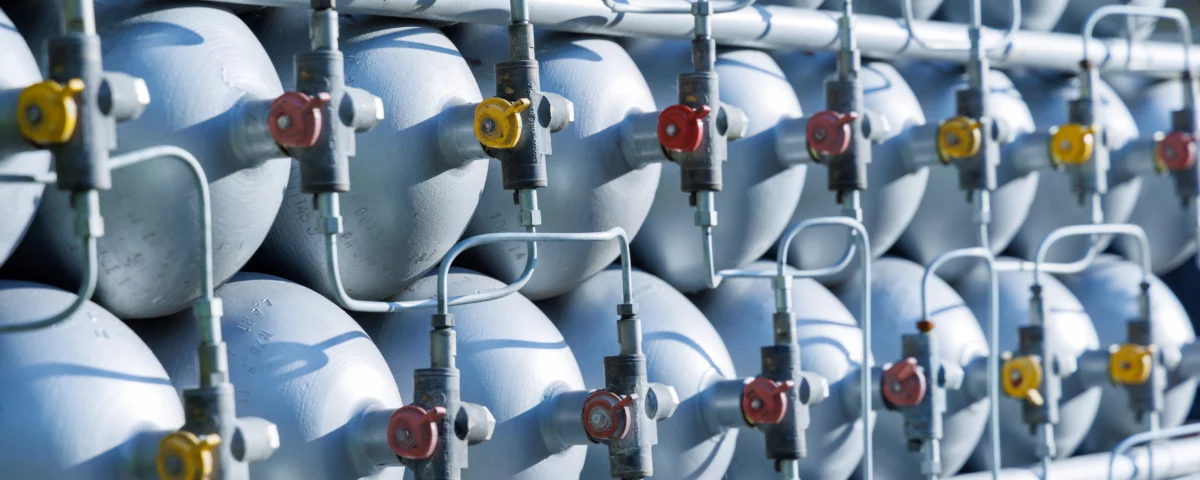- For secure high-pressure
- +36 62 999 051
- info@pwent.eu
Storing Hydrogen Safely: Best Practices for Businesses
Last Updated on 1 year by admin
Hydrogen, the simplest and most abundant element in the universe, is making waves in various industries due to its potential as a clean energy source. Its high chemical reactivity, presence in water, and role in organic compounds make it a cornerstone in both industrial and environmental sectors. As a colorless, odorless, and flammable gas, hydrogen’s low density and non-toxic nature are advantageous, yet its handling demands careful consideration due to its reactivity and physical properties.
In this article, the Pwent team delves into the intricacies of distributing and storing hydrogen, especially for businesses.
Understanding Hydrogen
Hydrogen is the lightest and most abundant element in the universe, forming essential compounds like water and a myriad of organic substances. Its colorless, odorless, tasteless, and highly flammable nature defines its uniqueness. Despite being the least dense of all gases, its presence is almost ubiquitous in living organisms and water, and it exists in the atmosphere in trace amounts (one part per million).
The element is renowned for its high chemical reactivity, playing a pivotal role in acid-base reactions and forming diatomic gases. The element’s significant chemical reactivity necessitates careful handling due to its reactive nature and physical properties.
Nonetheless, hydrogen’s non-toxicity is a significant advantage. It poses no direct threat to human or environmental health upon release. Being lighter than air, it dissipates rapidly, reducing risks of dangerous accumulation. However, in enclosed or roofed areas, hydrogen’s tendency to accumulate can create hazardous situations. Therefore, it’s crucial to implement effective ventilation and monitoring systems in such environments to ensure safety and prevent potential risks associated with hydrogen storage and handling.
Discover the safety and efficiency of Pwent for all your hydrogen storage needs – your gateway to a cleaner energy future.
Storing Hydrogen: The Methods
Various techniques exist for storing hydrogen, including high-pressure containment for gaseous hydrogen and ultra-low temperature systems for liquid hydrogen. In this part, we discover the unique challenges and safety considerations of each method.
Storing Hydrogen (Gaseous)
In this approach, hydrogen is stored as a gas at high pressure. High-pressure gas cylinders can store hydrogen at levels up to 800 bar. In the context of hydrogen tank systems in vehicles, compressed hydrogen is stored at 200-300 bar (5,000 psi) and 700 bar (10,000 psi). A significant challenge in gaseous hydrogen storage is the requirement for robust, high-pressure solutions.
Storing Hydrogen (Liquid)
Hydrogen is converted into liquid form by cooling it to −253 °C. This liquid hydrogen is then stored in tanks, which are commonly utilized in vehicles and various other applications. The main challenge here lies in achieving and maintaining such ultra-low temperatures, which necessitates considerable energy expenditure.
Key Aspects of Storing Hydrogen
One critical aspect of the safe storage practices of hydrogen is the selection of materials and manufacturing processes. Hydrogen’s interaction with metals often results in a phenomenon known as hydrogen embrittlement, where metals become brittle and prone to cracking under stress. This particular characteristic of hydrogen requires the selection of specialized metals and the adoption of precise manufacturing processes tailored to mitigate its detrimental effects. Over time, the industry has witnessed numerous accidents attributable to an insufficient grasp of hydrogen embrittlement. These incidents highlight the critical need for meticulous material selection and engineering design that specifically accommodates the challenging properties of hydrogen to ensure structural integrity and safety.
Additionally, hydrogen’s behavior under usage is distinct. Unlike other gases, hydrogen tends to heat up upon expansion rather than cool down. This unique property, known as the Joule-Thomson effect, requires careful consideration in the design and operation of hydrogen storage systems to manage the thermal effects and ensure safe handling.
Choose Pwent for unparalleled safety and cutting-edge hydrogen storage and transportation solutions.
Transmission and Distribution of Hydrogen
For regions with substantial, consistent hydrogen demand, pipelines offer an efficient distribution method. Hydrogen pipelines can transport up to 88% of the energy content of methane pipelines, making them a viable option for large-scale distribution.
Exploring Diverse Applications
The scope of hydrogen distribution extends into other exciting areas, such as green energy initiatives and solar water purification and storage. These applications demonstrate the versatility and growing importance of hydrogen in various sectors.
Notable Projects
Our experience in distributing and technologies for storing hydrogen includes participation in significant Hungarian projects. We supplied bundles for the Mátraháza power plant, enhancing its operational efficiency. Additionally, for the Kardoskút Aquamarine project, we provided storage ISO containers and bundles, showcasing our capability to cater to diverse project requirements.
Safety and Innovation in Hydrogen Distribution
Ensuring safety in hydrogen distribution is crucial, especially considering the material brittle effect and unique thermal properties of hydrogen. These aspects have been carefully considered in our projects, like Mátraháza and Kardoskút Aquamarine, to prevent past issues related to material degradation and thermal management. Our approach to storing hydrogen not only prioritizes safety but also embraces innovation, adapting to the evolving needs of the energy sector and beyond.
What Makes Pwent the Preferred Choice?
Pwent distinguishes itself in storing hydrogen and the transportation sector through its dedication to safety, efficiency, and innovative practices. The company has adopted the best manners for managing hydrogen, enabling businesses to use hydrogen safely and confidently. With its advanced storage solutions and trailblazing distribution techniques, Pwent products are leading the charge in tapping into hydrogen’s potential for a sustainable future.
Storing Hydrogen Safely: Best Practices for Businesses
Understanding hydrogen’s properties and safe handling practices is crucial for businesses considering it as a viable and clean energy source. Storing hydrogen from gaseous to liquid, with innovative distribution methods like pipelines and high-pressure containers, the hydrogen landscape is evolving rapidly. Embracing these advancements with a focus on safety and efficiency is key to unlocking the future of hydrogen storage solutions’ full potential in the energy sector and beyond.
Embrace the future of energy with Pwent: Your trusted partner in safe and innovative hydrogen storage and transportation.






